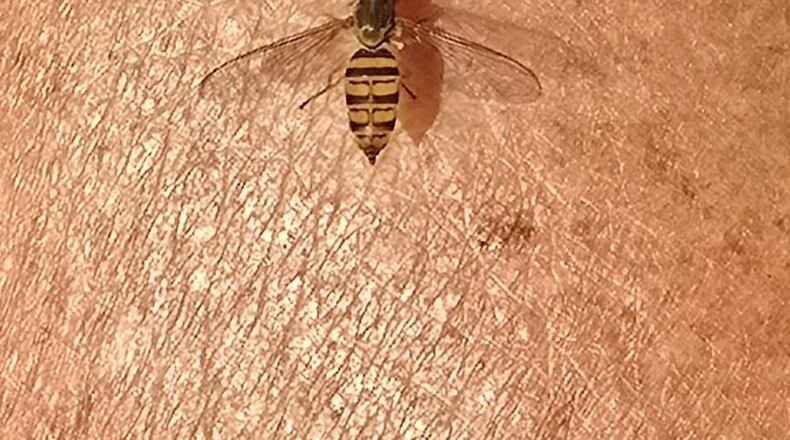The population this year is even greater than in 2018. It is causing great annoyance to anyone sitting outside, trying to enjoy a meal, a ballgame or just sitting by the pool. They are everywhere.
I spoke with colleagues around the state this week, and the western part of the state seems to have an abundance of them. Friends in northeast Ohio are seeing normal numbers.
These hover or syrphid flies are members of the order Diptera and the family Syrphidae. They are considered good as they are beneficial insects. They can eliminate soft-bodied pests such as aphids, scales or thrips. They are also great pollinators.
Hoverflies are around a quarter of an inch to an inch and a quarter long, depending on the species. The species we are predominantly seeing are about a quarter of an inch long, with black and yellow bodies.
Hoverflies have short antennas and eyes that are large relative to their head size and wrap around the head capsule. Bees and wasps usually have longer antennae.
The most distinguishing characteristic of a hoverfly is that they have two wings or one pair. Bees and wasps, on the other hand, have four wings or two pairs. Bees sting while hoverflies don’t.
All flies’ mouthparts are similar to a sponge. They don’t bite but rather have mouthparts that dab. They dab the surface of your skin, likely seeking salt and moisture.
This dabbing habit is annoying because they tickle while dabbing. If you watch closely when one lands on your skin, you can see this process. That is, if you can tolerate the tickling for a few minutes!
Hoverflies overwinter as adults or fully grown larvae. The larvae have a maggot-like appearance and hooks for jaws, making them perfect for feeding on aphids and other pests. They are considered a natural pest control.
The adults spend most of their time hovering. I was at a football game this past week and there were about 15 of them hovering around my legs. Getting a photo was a challenge, but I managed.
Hover or syrphid flies are native throughout eastern North America. Populations tend to ebb and flow, as with all insects. I didn’t see that many after the first year, but populations have grown significantly in the last two.
You are not going to find pesticide recommendations for the control of hoverflies since they are beneficial. A spray such as Off or other insect repellent holds them at bay and allows you to at least enjoy the game.
Credit: CONTRIBUTED/Pa
Credit: CONTRIBUTED/Pa
Credit: CONTRIBUTED/David Shetlar
Credit: CONTRIBUTED/David Shetlar
Pamela Corle-Bennett is the state master gardener volunteer coordinator and horticulture educator for Ohio State University Extension. Contact her by email at bennett.27@osu.edu.
About the Author

